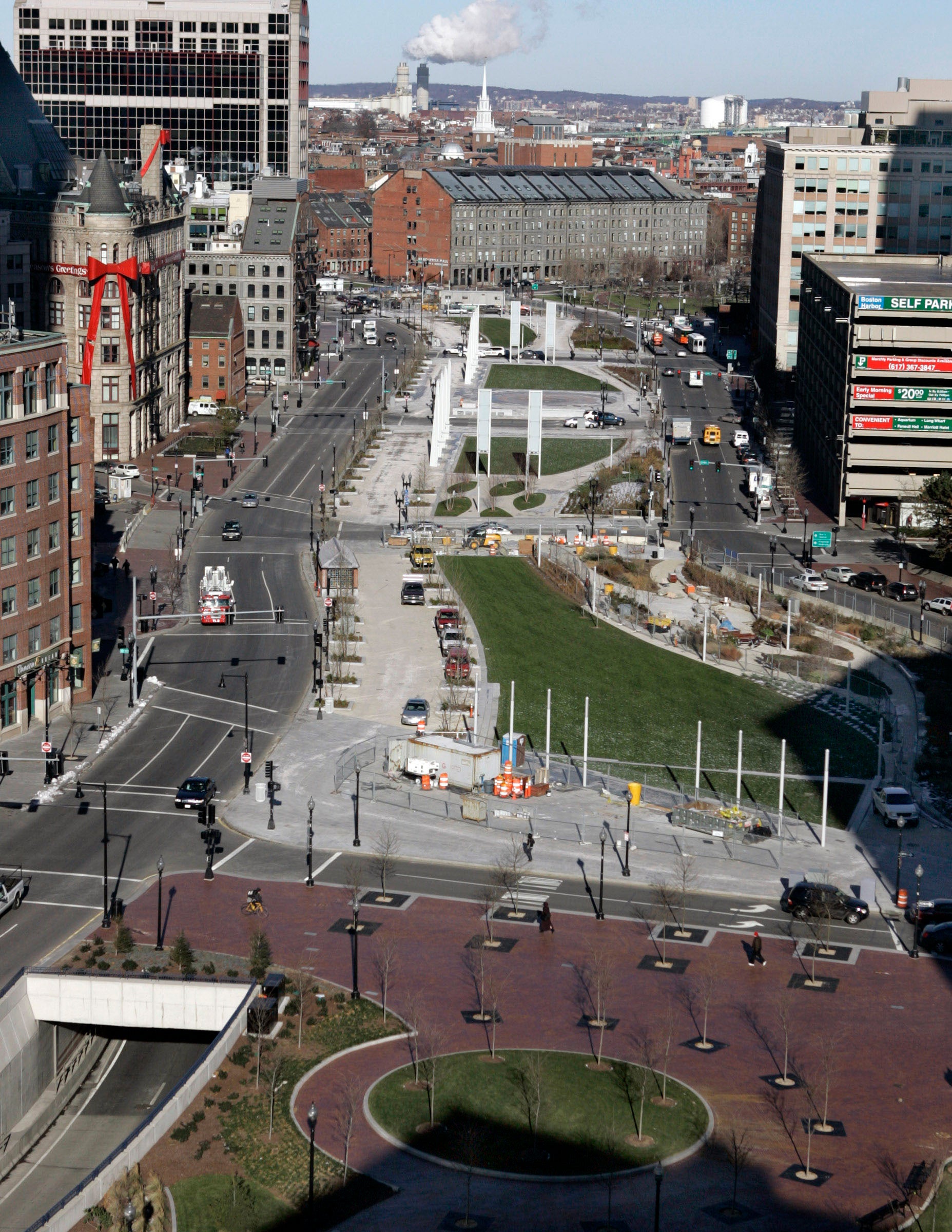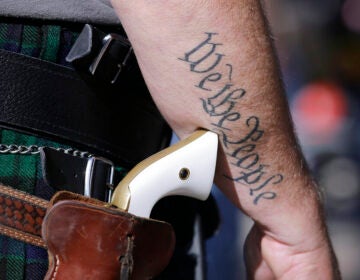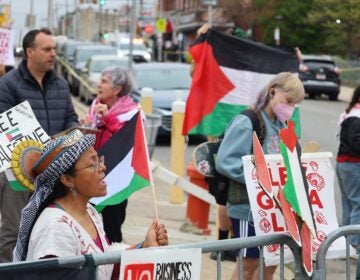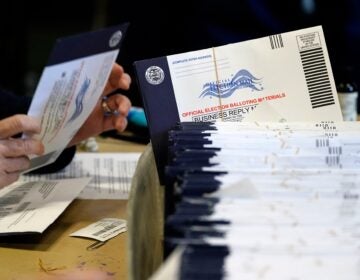What ideas would locals steal from other cities? They center around getting around
Listen
The Rose Fitzgerald Kennedy Greenway in Boston. It sits where the elevated Central Artery once snaked through downtown Boston. (AP Photo/Elise Amendola)
Sometimes, a little envy can be a useful thing.
A few weeks ago, I posed a question to folks who live around here.
When you go to other cities or countries, do you ever see something – some civic amenity – that has you saying to yourself, “Boy, I really wish we had that back home?”
Responses were numerous and lively. Let me report on a few trends in the answers.
First: Cars, trains and bikes.
That was the dominant theme of responses from Philadelphians. Residents of cities farther west seem a little less obsessed with matters of transportation.
A stream of Philadelphians lamented how car-centric decisions, chief among them the placement of Interstate 95 along the Delaware riverfront, have wounded the fabric of Center City. People looked at Boston with Big Dig and Greenway envy.
Several people mentioned that water taxis would be a sweet move to help people move up and down a central riverfront that, while increasingly lively, is chopped up and thwarted by decades of poor planning decisions.
People who have visited or lived in European cities tended to comment how far SEPTA falls short on frequency of schedule, ease of use and aesthetics of stations.
Still in the transit vein, many were geared up for a better system of safe, dedicated bike lanes. And for pedestrian malls.
They don’t call it Filthydelphia for nothin’, and suggestions were legion on how to emulate other places in discouraging litter, and picking up what trash may fall. Also, one person reported that he’s actually seen a city where weeks don’t elapse between the chewing up of macadam to prep a street for repaving, and the actual repaving.
Finally, let me second the comments of Justin Harbor, a Millennial from Mt. Airy who wants Philly to do much more to connect, through transit and narrative, its rich but scattered historical treasures. Germantown, for example, remains a secret to many history buffs who visit Old City without knowing how in many ways it enriches the story they came to see. As Harbor notes, Boston, with its Freedom Trial narrative device, ends up doing more with arguably less.
Overall, what came across in the responses was how fervently people wish the cities they love could be a little bit more agile and inventive – and how durable is their hope for a better day.
Here’s a sampling of the most thoughtful comments. (To see more comments, read my original commentary; to add your own thoughts use the comment space below.)
Shanna Reimer: I never owned a car or needed to rent one more than a couple times a year until I moved here. I was SHOCKED at how car-centric this area is for a major metropolitan area. One of the reasons I took the job I have now is that it was close to a SEPTA train station and I really miss being able to commute by walking to and from a train station.
But I quickly discovered that the SEPTA rail system is just a bunch of silos that have next to no relationship with each other. Even though I could walk to one transit point at my old home in King of Prussia, and walk from the station here in Morton to my job, I still ended up commuting by car because there are zero transfer points between those two lines and I would have had to crisscross the city to get where I needed to go – making my commute 2.5 hours instead of the .5 to 1 hour it was in traffic.
I read somewhere that European attitudes about “public” spaces, transportation, and services are that they are “for everyone” and that American attitudes are that they are “for everyone who can’t afford private” and therefore not worth bothering about. DC and New York have much more European attitudes – you see Senators, celebrities, even Mayor Bloomberg on public transport.
But here? As soon as I mentioned that I WANTED to commute by train I got thrown the craziest looks. I think the Philadelphia region public transport system could use a major European overhaul in attitude, and a lesson from DC about making the system usable across many areas!
Paul Rider: First I have to say there is a movie which all of Philadelphia’s city council should watch called Urbanized, which is available on Netflick’s streaming. This is a movie which goes to cities around the globe and discusses some of the various issues you brought up but even going further.
The one section, which is based in Bogota, Colombia, is especially one that I though feels quite in sync with where Philadelphia is right now. We have limited highways to get people around and the cost of building the infrastructure of rails, either subway or light rail, would be out of the question.
Bogota came up with an interesting solution by creating a bus system similar to a subway with exclusive lanes or throughways for the buses and an entry way similar to a subway system. The idea is based on not the amount of cars on the roads, but the lack of parking. They realized that everyone thought that there was a god given right to be able to park their car at the final destination which contributed to the amount of cars on the roads.
They also invested in bike only throughways – not a bike lane, which ends up being free parking for twenty or so minutes, but separate roads just for bikes. The section on Copenhagen is also good to view for how they deal with bike lanes, far more civilized in that the bike lane is next to the sidewalk, then the parked cars, then the roadway.
Justin Harbour: I am a transplant of Boston, living and working in Philadelphia for 2 years now (live in Mt. Airy, work in South Philly). The one thing about Boston that strikes me as an advantage over Philadelphia is the effects of the Rose Kennedy Greenway and its use of green spaces generally. The Greenway was a byproduct of the Big Dig, which is too much of a financial commitment for cash-strapped PA to consider right now (and perhaps not as necessary). But the public green space and garden that now sits atop it has been a wonderful addition to Boston. Not only is it a peaceful oasis in that part of the city with its manicured gardens, it is very conducive to spontaneous civic interactions with the many sitting/resting/eating areas, fountains, etc. If you can recall what that part of Boston was like when Interstate 93 was there, the transformation is tremendous. It is clean, peaceful, and welcoming (in a city not always welcoming, to even its own).
The Greenway also encouraged substantial economic growth. ,,,
I could imagine something similar in Philadelphia to the same tremendous effect. The water front on the Delaware is screaming for similar development, paralleling the development along the Schuykill in recent years. Though there is less geographic (man made or natural) segregation in Philly in comparison to Boston, these types of strategically placed green-spaces encourage people to leave their secluded homes and neighborhoods, to the civic and economic benefit of the city. If there could also be areas identified that are conducive to Greenway-like developments between neighborhoods, all the better. Perhaps between Art Museum and Brewerytown, or places to connect South Philly to Center City and their popular neighborhoods like Graduate Hospital and Navy Pier.
Even, perhaps, right down the center of Broad (too idealistic?). Wherever they may be located, and the ultimate ideal would be to have them connected to each other, is to encourage travel to and in between neighborhoods, instead of encouraging merely sedentary and temporary relief. This brings me to my second need for Keystone Crossroads: pedestrian connectivity to surmount tourist centralization.
In Philadelphia there are largely two tourist areas: Olde City and the Parkway with its museums. Now, planners cannot be blamed for the placement of Independence Hall and some of its neighboring and associated locations (the American Philosophical Society, the original Federal Reserve, etc.). It is the same for the Philadelphia Art Museum. But not much else has been done to encourage similar developments of tourist destinations in other areas of the city.The opposite has instead occurred, with new developments clustering around these foundations. The two most obvious that come to mind is the Barnes museum and the National Constitution Center. Both animate tourist interest (perhaps significant interest). And I will admit that that interest may be magnified due to their location to other staples of Philly’s tourist industry.
But the fact remains that a visit to Philadelphia could include a visit to only these two clusters of tourist attractions, and bypassing the entire rest of the city. Such bypassing harms Philadelphia’s economic health and development potential (not to mention civic pride and the encouragement of civic obligation and allegiance). Many other cities I have visited or lived in decentralize their tourist attractions. Boston has the “Freedom Trail” connecting many disparate neighborhoods through a careful and important historic narrative that could only be rivaled by the few American cities with similar histories, of which Philadelphia is arguably number one. Philadelphia must encourage and incentivize travel to other parts of this diverse city.
Germantown is one example of a tourist treasure that separately needs the economic benefits of increased tourist traffic. But there exist other obvious examples. These areas rich with potential and cultural vibrancy all seem to be relegated to the knowledge of Philly’s residents only. Yet they prove time and again to be valuable and enticing treasures capable of encouraging and sustaining a civic and economic revival. Philly’s planners therefore should be much more strategic about how they encourage connectivity.
… Philadelphia is uniquely situated in that millennials are coming here in drives from the Northeast’s more expensive urban areas. They are also reporting that they are unlikely to remain here unless some things improve. Speaking as a millennial, I want my young son to grow up in a place that encourages diversity, not segregation. I also want to raise my family in a place that exploits multiculturalism and history, instead of confining it so as to hide it other parts away. Looking to new and compelling ideas in other large cities in America and beyond is the first step to addressing this lack of substance in our connectivity and urban creativity. Bold leadership in reducing cultural and tourist segregation and encouraging connectivity is an essential first step to ensuring Philadelphia’s vibrancy in all dimensions for the short and long-term.
WHYY is your source for fact-based, in-depth journalism and information. As a nonprofit organization, we rely on financial support from readers like you. Please give today.




